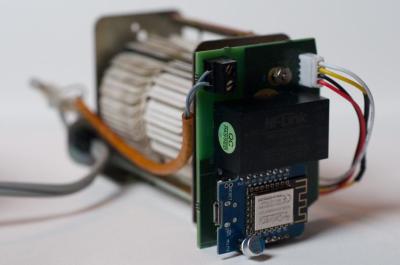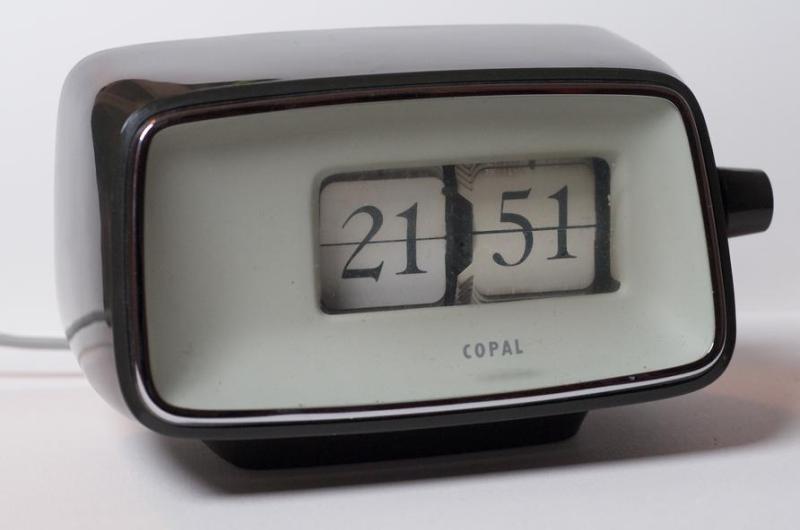Many of the clocks we feature here on Hackaday are entirely built from scratch, or perhaps reuse an unusual display type. But sometimes, an old clock is just perfect as it is, and only needs a bit of an upgrade to help it fit into the modern world. One such example is the lovely 1960s Copal flip clock (in German, Google Translate link) that [Wolfgang Jung] has been working with — he managed to bring it squarely into the 21st century without changing its appearance one bit.
Like most flip clocks from the 60s and 70s, the Copal clock uses a small synchronous AC motor to advance the digits. Because this motor runs in step with the mains frequency, it also acts as the clock’s timing reference. However the original motor had died, and a direct replacement was impossible to find. So [Wolfgang] decided to replace it with a modern stepper motor. He designed a small PCB that fit the original housing, on which he placed a Trinamic TMC2225 stepper motor driver, a Wemos D1 Mini and a small 5 V power supply.
 Thanks to its WiFi connection, the D1 can find out the correct time by contacting a Network Time Protocol (NTP) server. Displaying that time would be tricky with the original hardware though, because there is no indication of which numbers are displayed at any time. [Wolfgang] cleverly solved this problem by placing an IR proximity sensor near the lowest digit, allowing the D1 to count the number of digits that have flipped over and thereby deduce the current state of the display.
Thanks to its WiFi connection, the D1 can find out the correct time by contacting a Network Time Protocol (NTP) server. Displaying that time would be tricky with the original hardware though, because there is no indication of which numbers are displayed at any time. [Wolfgang] cleverly solved this problem by placing an IR proximity sensor near the lowest digit, allowing the D1 to count the number of digits that have flipped over and thereby deduce the current state of the display.
There’s plenty of fun to be had with classic flip clocks like this, and with a bit of hacking any old split-flap display should be usable for your own clock project. If none are available at your local thrift store or yard sales, you can always roll your own.















Hi,
I’ve added the project to github: https://github.com/elektro-wolle/flip-clock
Have fun and keep on hacking
Wolfgang
its not clear from the build log how he detects the minutes. they fall, but how does he know what they show? did he mark the zero flap?
On booting the clock, the user has to enter manually the currently shown time on the clock, timezone as well as the wifi credentials. After that, it is only counting the minutes to the actual time and flipping forwards (or waiting, if the shown time is less than a few minutes in the future).
Impress me,,,,,add a WWVB receiver :)
Those of us in New England find their performance marginal. I have three, and they need to be oriented just right to reliably update…
NIST didn’t really publicize this much, but they added a PSK modulation to their signal on top of the regular AM signal and newer WWVB receivers designed to pick up on this have WAY better reception than before. I never could get “atomic” clocks to work here in Boston, but recently bought a new “Ultratomic” branded clock that had the new receiver design, and it immediately got the time, during the day, minutes after first putting in batteries, here in Boston. Hoping cheap modules capable of receiving the new signal modulation become widely available, because I’m pretty impressed at how well it works now.
Something similar was done with DCF-77, I vaguely remember.
It also got another modulation type (PM?) atop of the existing one (AM) .
Nice thing about DCF-77 time signal is that its pulse alone can be used for timing. A purely electromechanical clock with a primitive crystal radio could be driven by it, in theory, I mean.
In a post-apocalyptic world, DCF-77 could still be useful thus. ;)
BPSK WWVB Receiver kit.
https://universal-solder.ca/product/everset-es100-wwvb-starter-kit/
I wonder of it’d be much more complicatedto retriever thé time from RDS instead of NTP si the clock would not require internet access.
I have a problem with RDS where I live. Several stations don’t bother to ever synchronize the time on whatever equipment they use to inject RDS into the composite broadcast. That throws my Sangean table radio off by up to hours if it happens to find RDS data from one of those scofflaw broadcasters. Fortunately, there’s an option to set time manually.
On the other hand, I have an older Sangean clock radio with a very large WWVB bar antenna on the back and it stays properly synced.
This seems a little over the top, since the original clock ran off a synchronous motor which tracked the 60hz line frequency. Power companies adjust the frequency at night to make up for the daytime loads and correct the clocks.
“Welcome at hackaday, were we strife to do things different, no matter how!”
Reminds me of a story here in Europe.
A few years ago, the 50Hz signal was slightly off, so radio alarm clocks had wrong time.
A few weeks later (?), the line frequency was “corrected” (it now was off the otherway round) to address the problem.
The result was that radio clocks had wrong time a second time, because citizens had corrected the time on their radio clocks on their own in the meantime.
Seriously, what were those power companies/agencies expecting? That citizens do wait for days/weeks for a correction? *sigh*
Deutsche Welle reported in 2018 that clocks in the EU’s ENTSO-E power collective of 36 countries had lagged about five minutes behind what should have been the standardized time due to the grid frequency lagging below 50 Hz. DW blamed power operators on Serbia/Kosovo for causing the drift. The implication was that being a collective, the scofflaws generating at too low a frequency could not be simply cut off and the whole grid had to accommodate the error.
Here in the US Oak Ridge Laboratory in conjunction with University of Tennessee have a web site called FNET/Grid Eye which monitors frequency and phase though a network of volunteer precision monitors. Other parts of the globe are monitored as well. It is pretty neat, and worth a browse.